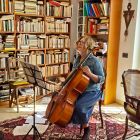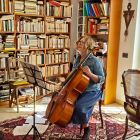Duccio: Mediaeval art comes alive
On a fine noon on 9 June 1311 all the shops were shut and all the bells were ringing in the fortified Tuscan town of Siena. There was a sound of drums and fifes and trumpets and castanets. All the people were singing. In triumph they carried a huge, beautiful painting blazing with colour and gold from the workshop of master Duccio in Via Stallareggi to the great cathedral.
After three years of work the great painter had finished his homage to the special protector of his town, the Virgin Mary enthroned with her child, surrounded by a wreath of saints and angels and bright tales a huge picture for all to worship.
The city of Siena was a rich republic. She was strategically situated, sitting on the hub of the most important trade and pilgrim route in Europe, the Via Francigena, which reached from Rome to northern France and Spain, and even to Canterbury. She had her own currency, was the first city to develop a banking system, and invented a complex experiment in government.
In the 13th century, without printed books or other visual stimuli, painted images in public places were the only news. The efforts of those who made them were considered less aesthetic than political; the painters were used to explain the dogmas and ambitions of the temporal authority or the Church. They were not much more than fancy craftsmen, and as such they had to belong to a guild.
Duccio di Buoninsegna was born in 1260. As a journeyman he travelled to Rome, probably to Paris, certainly to Florence. There he worked under the established master Cimabue, 20 years his senior. Then, himself a master, he was commissioned to paint frescoes in S. Croce (Cappella Bardi) and the Rucellai Madonna, a huge portable altarpiece. All the paintings were on wooden panels which would be carried to altars. They were free-standing like sculpture, painted front and back.
Duccio was over 40 when he was commissioned to create a Maest, a seated Madonna with her child, for the great cathedral of his home town. The contract stipulated that he could not accept any other work while engaged in this task.
From 1308 to 1311 he worked with his assistants in his bottega or workshop. He smoothed the 4-metre wooden panel, laid gold leaf over it, decorated this with incisions, and then painted layer upon layer of egg tempera paint strokes in the brightest of persimmon orange, pomegranate red and midnight blue, a huge, sparkling shield of gold and blazing colour.
At the time the Byzantine style still predominated. It came from the east and the Greco-Roman tradition. Mosaics and cloisonn work had taught it brilliant colour, sculptural measure, gravity and pronounced outline. Reality was translated into formula. The rules of iconography were strict. The painter was only an instrument guided by the hand of God to fashion powerful, mystical objects which would generate worship and faith: the icon. It could be beautiful, but it had to be stern and rigid.
But a new wind was coming down the trade routes from the north; the French Gothic brought a taste for refined, elegant figure, graceful curve, and ornament. Cimabue in Florence and others hesitated before the new air. It was Duccio who gradually broke through.
From the Byzantine he elaborated a mediaeval style, the Italian form of the Gothic. Slowly the faces of mother and child became softer and more rounded and rosy like fruit, brushed more gently. Angels and saints developed a subtle, sloe-eyed sideways smile, while a tapestry of mediaeval patterns bloomed behind them.
But what makes Duccios new style most vivid is a wonderfully fluid accent. Look at the hems of his Madonna mantles, that line of gold on dark. Like a fine, liquid thread it runs down the middle of each figure. It tumbles and dances and cascades down in delighted curlicues, lingering and rippling like a stream in spring. This endless golden abstract arabesque is the painters own personal speech, his freedom, his poetry, his signature.
This large, probing show, based at S. Maria della Scala, a huge mediaeval space and former hospital that has been painstakingly remodelled, does Siena and one of her finest sons proud. You see the golden line in its most exquisite examples: the tiny Madonna with three Franciscans from the Pinacoteca, probably done at the same time as the enormous Rucellai in the Uffizi, and another tiny centrepiece, the so-called Berne Madonna. Both are jewels of high mediaeval art.
There is a group of freshly-restored panels depicting the passion of Christ from the cycle on the back of the Maest. Others are in the Opera del Duomo museum nearby, 11 have been dispersed in international collections. Here the terrible last days of Christ take place not in Jerusalem, but in the streets of Siena.
Further the show offers us an astonishing chance: to see the enormous round window of stained glass Duccio made for the cathedral, now entirely restored. The Coronation of the Virgin, made in 1288, is in nine sections. We can study Duccios working hand from up close: the painstaking way he applied grey paint (grisaille) to the front and back of the pane with steady, even brushwork to accentuate and to model the face and limbs. Once the vetrata is lifted back into its place ten metres high in the cathedral, no one will be able to look over the masters shoulder again and spy his details.
The work of Duccio and those before and around him is still coolly ceremonious. But two paintings by his most brilliant follower, Simone Martini, and two by the gentle Ambrogio Lorenzetti, point to things to come, the sweetness and wisdom of sentiment of the full flowering of Sienese 14th-century art.
Your ticket to this careful, too careful, exhibition also allows you to visit the nearby Opera del Duomo, where the Maest and its parts are permanently installed, along with vigorous Giovanni Pisano sculptures from the faade of the cathedral. You can see the cathedral crypt where frescoes supposed to be by Duccio and his followers have recently come to light. Another fresco attributed to him, of the surrender of the beleaguered fortress of Giuncarcio in 1314, is in the Palazzo Pubblico right beneath the famous Guidoriccio riding into the night by Simone Martini.
In the show itself the small panels of the Madonna with the three Franciscans and the Berne Madonna, demure little women sitting against wonderful lively patterns, say the most about the mediaeval master.
Duccio 1260-1319 and the origins of Sienese painting. Until 11 Jan 2004. Probably to be extended. Sun-Thurs 09.00-19.30, Fri-Sat 09.00-22.00. Tel. 0577296539, 0577296753.
Picture: Coronation of the Virgin - a detail from the stained glass window by Duccio in Siena cathedral.





















